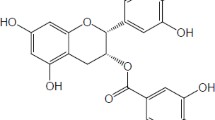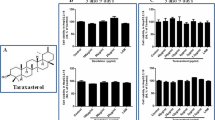Abstract
Hepatitis B virus(HBV) infection is a severe health problem in the world. However, there is still not a satisfactory therapeutic strategy for the HBV infection. To search for new anti-HBV agents with higher efficacy and less side-effects, the inhibitory activities of traditional Chinese medicine Rheum palmatum L. ethanol extract(RPE) against HBV replication were investigated in this study. Quantitative real-time polymerase chain reaction(PCR) was employed to analyze the inhibitory activity of RPE against HBV-DNA replication in a stable HBV-producing cell line HepAD38; the expression levels of HBV surface antigen(HBsAg) and e antigen(HBeAg) were also determined by enzyme linked immunosorbent assay(ELISA) after RPE treatment. RPE could dose-dependently inhibit the production of HBV-DNA and HBsAg. The concentration of 50% inhibition(IC50) was calculated at 209.63, 252.53 μg /mL, respectivel y. However, its inhibitory activity against HBeAg expression was slight even at high concentrations. RPE had a weak cytotoxic effect on HepAD38 cells(CC50 = 1 640 μg /mL) and the selectivity index(SI) was calculated at 7.82. Compared with two anthraquinone derivatives emodin and rhein, RPE showed higher ability of anti-HBV and weaker cytotoxicity. So Rheum palmatum L. might possess other functional agents which could effectively inhibit HBV-DNA replication and HBsAg expression. Further purification of the active agents, identification and modification of their structures to improve the efficacy and decrease the cytotoxicity are required.
Similar content being viewed by others
References
Andersen D O, Weber N D, Wood S G, et al. 1991. In vitro virucidal activity of selected anthraquinones and anthraquinone derivatives[J]. Antiviral Res, 16:185–196.
Ayoola E, Balayab, MS, Deinhardt, F, et al. 1998. Progress in the control of viral hepatitis: Memorandum from a WHO Meeting[J]. Bull World Health Organ. 66:443–455.
Barnard D L, Huffman J H, Morris J L, et al. 1992. Eva-luation of the antiviral activity of anthraquinones, anthrones and anthraquinone derivatives against human cytomegalovirus[J]. Antiviral Res, 17: 63–77.
Blumberg B S. 1998. Hepatitis B virus: search for plant-derived antiviral[M]. Tomlison TR, Akerele D, ed. Medical Plant-Their Role in Health and Biodiversity. Philadelpha: University of Pennsylvania Press.
Custer B, Sullivan S D, Hazlet TK, et al. 2004. Global epidemiology of hepatitis B virus[J]. J Clin Gastroenterol, 38:S158–168.
Doong S L, Tsai C H, Schinazi R F, et al. 1991. Inhibition of the replication of hepatitis B virus in vitro by 2′,3′-dideoxy-3′-thiacytidine and related analogues[J]. Proc Natl Acad Sci USA, 88: 8495–8499.
Feld J, Locarnini S. 2002. Antiviral therapy for hepatitis B virus infections: new targets and technical challenges[J]. J Clin Virol, 25:267–283.
Humphries J C, Dixon J S. 2003. Antivirals for the treatment of chronic hepatitis B: current and future options[J]. Intervirology, 46:413–420.
Karayiannis P. 2003. Hepatitis B virus: old, new and future approaches to antiviral treatment[J]. J Antimicrob Chemother, 51:761–785.
Kruining J, Heijtink R A, Schalm S W. 1995. Antiviral agents in hepatitis B virus transfected cell lines: inhibitory and cytotoxic effect related to time of treatment[J]. J Hepatol, 22:263–267.
Ladner S K, Otto M J, Barker C S, et al. 1997. Inducible expression of human hepatitis B virus(HBV) in stably transfected hepatoblastoma cells: a novel system for screening potential inhibitors of HBV replication[J]. Antimicrob Agents Chemother, 41:1715–1720.
Lee W M. 1997. Hepatitis B virus infection[J]. N Engl J Med, 337:1733–1745.
Liaw Y F. 2002. Therapy of chronic hepatitis B: current challenges and opportunities[J]. J Viral Hepat, 9:393–399.
Maddrey W C. 2000. Hepatitis B: an important public health issue[J]. J Med Virol, 61:362–366.
Mosmann T. 1983. Rapid colorimetric assay for cellular growth and survival: application to proliferation and cytotoxicity assays[J]. J Immunol Methods, 65:55–63.
Peigen X, Liyi H, Liwei W. 1984. Ethnopharmacologic study of Chinese rhubarb[J]. J Ethnopharmacol, 10:275–293.
Rawat M S, Negi D S, Panwar M S, et al. 1989. Anthraqui-none glycosides from Rheum moorcroftianum Royle[J]. Pharmazie, 44:509–510.
Schinazi R F, Chu C K, Babu J R, et al. 1990. Anthraquinones as a new class of antiviral agents against human immunodeficiency virus[J]. Antiviral Res, 13:265–272.
eeger C, Mason W S. 2000. Hepatitis B virus biology[J]. Microbiol Mol Biol Rev, 64:51–68.
Semple S J, Pyke S M, Reynolds G D, et al. 2001. In vitro antiviral activity of the anthraquinone chrysophanic acid against poliovirus[J]. Antiviral Res, 49:169–178.
Su Z, Zeng Y, Zhou H, et al. 1999. Preliminary study on chemical changes in the decocting process of radix et rhizoma Rhei[J]. J Chinese Material Medica, 24:291–292, 318.( in Chinese)
Sydiskis R J, Owen D G, Lohr J L, et al. 1991. Inactivation of enveloped viruses by anthraquinones extracted from plants [J]. Antimicrob Agents Chemother, 35:2463–2466.
WHO. 1998. Hepatitis B. Fact Sheet WHO/204. November.
Zhang B, Chen J, Li H, et al. 1998. Study on the Rheum palmatum volatile oil against HBV in cell culture in vitro[J]. J Chinese Medicinal Materials, 21:524–526.(in Chinese)
Author information
Authors and Affiliations
Corresponding author
Additional information
Equally corresponding author.
Rights and permissions
About this article
Cite this article
Sun, Y., Li, Lj., Li, J. et al. Inhibition of hepatitis B virus replication by Rheum palmatum L. ethanol extract in a stable HBV-producing cell line. Virol. Sin. 22, 14–20 (2007). https://doi.org/10.1007/s12250-007-0056-6
Received:
Accepted:
Published:
Issue Date:
DOI: https://doi.org/10.1007/s12250-007-0056-6




